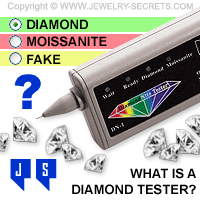WHAT IS A DIAMOND TESTER?
HOW DO DIAMOND TESTERS WORK AND WHY USE THEM?
This post contains affiliate links. If you use these links to buy something I may earn a commission. Thanks! As an Amazon Associate I also earn from qualifying purchases.

Every time you turn around in a Jewelry Store, something’s Beeping…
beep Beep BEEP!
That beeping is the sound of a diamond tester.
It’s testing a stone to see whether or not it’s genuine. The stone could be a diamond, moissanite or any other diamond simulant like a CZ (Cubic Zirconia).
What are diamond testers?
Diamond testers are little, hand-held (see picture) devices (although they do make some that sit on the desk) that tests for both the thermal conductivity (which is the ability to transfer heat) of a diamond, and also the newer ones test for electrical conductivity (which is used for distinguishing moissanites from diamonds).
Take a look at the great deals on Amazon for diamond testers.
Diamonds have a very high thermal conductivity (this is why diamonds always feel cool to the touch). Their thermal conductivity is much higher than any other gemstone… Almost.
Moissanites
Moissanites (man-made diamond simulants) are the next closest stone to have this heat transfer. This is why modern diamond testers now check for both thermal and electrical conductivity (jewelers were having a hard time telling the difference between the two stones before these testers were created).
Diamond testers normally have a retractable tip that gets placed on the stone in question (placed on the table of the stone). If the stone is a diamond, there will be a steady beep.
If it doesn’t beep or gives a warning beep, then it’s not a diamond (it’s a fake).
If it beeps steady and then changes to a higher pitch it usually means it’s a moissanite (before the new testers, moissanites would just beep like a real diamond).
LED displays
Most Diamond testers also have easy to read LED displays that light up different colors. Green for diamond, red for moissanite… (customers are fascinated by this).
It really is quite simple. Within just a couple of seconds, you can tell if a stone is diamond, moissanite, or something else.
Jewelers use diamond testers on a daily basis.
They have to.
Anytime they take in repairs, they test the merchandise (or should) just to make sure they’re real (fake stones can burn or crack under the intense heat of a torch).
When customers want to sell their rings, pendants, earrings and bracelets, the jeweler tests all of the stones to make sure they’re real. One can never be too certain. Sometimes a fake stone can look good enough to fool.
Everyone is protected
Jewelers also use diamond testers when showing diamonds to customers. They test the diamonds before and after they let a customer view them (this annoys some customers but amuses others). This also ensures that the stone in in fact still a diamond, and that the diamond wasn’t switched by a con artist.
It keeps everyone safe, secure and protected.
Yes it’s true… Jewelers are just as cautious about diamond wwitching as customers are.
And it works too… When unscrupulous customers see that this particular jeweler is checking their diamonds… They move on. They go to another not-so-careful jeweler to see if they can steal their diamonds instead (heads up jewelers).
So that beep – beep sound is a great thing.
(Just like the Road-Runner.)
Plus, a lot of insurance companies now insist that jewelers do everything they can to protect against theft. Diamond testing is a huge step towards preventing fraud on everyone’s behalf.
Every diamond that comes and goes in a jewelry store is tested. After all, diamonds are a jeweler’s way of life. And it’s not a bad idea for customers to want the same…
So have your stones tested.
If you go into a jewelry store to get your jewelry cleaned. Have them test your stones in front of you (before and after you get them back). If you pick up jewelry repairs or sizings from jewelers, have them test your stones so you know you’re getting diamond back…
And one last thing you can do to protect yourself…
Microscope your jewelry.
Check them under a microscope or a 10x jeweler’s loupe to make sure that it’s your diamond… Which also means you must know what your diamond looks like. Know where your inclusions are. Memorize the diamond plot. View the laser inscription… Know your diamond.
These tools are designed to protect both jewelers and customers.
They are there for everyone’s benefit. Use them. It’s worth a couple of extra seconds (for the tester to warm up), to stop, relax, and listen for that BEEEEEEEP!
Get your diamond testers here.
Cheers! :)


















Just wanted to thank you for sharing your invaluable information. I’m a beginner in the collecting of used engagement rings. Your info will be so useful and I will return to read more.
Thank you